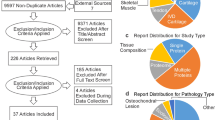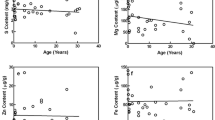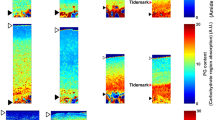Abstract
The yellow ligaments of the spine are characterized by an exceptionally high content of elastin, a protein with a proved longevity in several human tissues. This unique biochemical composition suggested a suitability of yellow ligaments for age estimation based on aspartic acid racemization (AAR), which was tested by determination of AAR in total tissue specimens and in purified elastin from yellow ligaments of individuals of known age. AAR was found to increase with age in both sample sets. The purified elastin samples exhibited a much faster kinetics than the total tissue, with ca. 3.7–4.6-fold higher apparent rates. The relationship between AAR and age was much closer in the purified elastin samples ( r =0.96–0.99) and it can therefore be used as a basis for biochemical age estimation. The analysis of total tissue samples cannot be recommended since the AAR values can be strongly influenced even by slight, histologically non-detectable variations in the collagen content. Age estimation based on AAR in purified elastin from yellow ligaments may be a valuable additional tool in the identification of unidentified cadavers, especially in cases where other methods cannot be applied (e.g. no available teeth, body parts).


Similar content being viewed by others
Notes
In proteins the so-called racemization of aspartic acid (AAR) involves both aspargine and aspartic acid that decompose via a succimide ring to the same four residues, namely L-aspartyl, D-aspartyl, L-isoaspartyl and D-isoaspartyl, all of which are in chemical equilibrium via the succimide ring (for overview see Ritz-Timme and Collins 2002). Asparingyl, aspartyl, isoaspartyl and succinimidyl residues, are all converted to free aspartic acid during acid hydrolysis, a preparative step in chromatographic amino acid analysis for biochemical age estimation.
The kinetics of AAR is described by the equation ln [(1+D/L)/(1−D/L)]=2 kAsp t+constant (where kAsp is the first order reversible rate constant for aspartic acid); for derivation of this equation see Bada and Schroeder (1975). Theoretically, the equation is valid only for free amino acids in aqueous solution but is has been used by the majority of groups working on age estimation based on AAR; to enable direct comparison it is also used here.
References
Bada JL, Schroeder RA (1975) Amino acid racemization reactions and their geochemical implications. Naturwissenschaften 62:71–79
Collins MJ, Waite ER, Duin ACT van (1999) Predicting protein decomposition: the case of aspartic-acid racemization kinetics. Philos Trans R Soc London Ser B 354:51–64
Daamen WF, Hafmans T, Veerkamp JH, Kuppevelt TH van (2001) Comparison of five procedures for the purification of insoluble elastin. Biomaterials 22:1997–2005
Duin ACT van, Collins MJ (1998) The effects of conformational constraints on aspartic acid racemization. Org Geochem 29:1227–1232
Fu S-J, Fan C-C, Song H-W, Wei F-Q (1995) Age estimation using a modified HPLC determination of ratio of aspartic acid in dentin. Forensic Sci Int 73:35–40
Mörnstad H, Pfeiffer H, Teivens A (1994) Estimation of dental age using HPLC-technique to determine the degree of aspartic acid racemization. J Forensic Sci 39:1425–1431
Ogino T, Ogino H, Nagy B (1985) Application of aspartic acid racemization to forensic odontology: post mortem designation of age of death. Forensic Sci Int 29:259–267
Ohtani S (1995a) Estimation of age from the teeth of unidentified corpses using the amino acid racemization method with reference to actual cases. Am J Forensic Med Pathol 16:238–242
Ohtani S (1995b) Estimation of age from dentin by using the racemization reaction of aspartic acid. Am J Forensic Med Pathol 16:158–161
Ohtani S (2002) Technical notes for age estimation using the femur: influence of various analytical conditions on D-aspartic acid contents. Int J Legal Med 116:361–364
Ohtani S, Yamamoto K (1987) Age estimation using the racemization of aspartic acid in human dentin. Nippon Hoigaku Zasshi 41:181–190
Ohtani S, Matsushima Y, Kobayashi Y, Kishi K (1998) Evaluation of aspartic acid racemization ratios in the human femur for age estimation. J Forensic Sci 43:949–953
Parks WC (1997) Posttranscriptional regulation of lung elastin production. Am J Respir Cell Mol Biol 17:1–2
Pfeiffer H, Mörnstad H, Teivens A (1995a) Estimation of chronological age using the aspartic-acid racemization method. 1. On human rib cartilage. Int J Legal Med 108:19–23
Pfeiffer H, Mörnstad H, Teivens A (1995b) Estimation of chronological age using the aspartic-acid racemization method. 2. On human cortical bone. Int J Legal Med 108:24–26
Powell JT, Vine N, Crossman M (1992) On the accumulation of D-aspartate in elastin and other proteins of the aging aorta. Atherosclerosis 97:201–208
Ritz S, Schütz HW (1993) Aspartic acid racemization in intervertebral discs as an aid to post mortem estimation of age at death. J Forensic Sci 38:633–640
Ritz S, Schütz H-W, Schwarzer B (1990) The extent of aspartic acid racemization in dentin: a possible method for a more accurate determination of age at death? Z Rechtsmed 103:457–462
Ritz S, Schütz HW, Peper C (1993) Postmortem estimation of age at death based on aspartic acid racemization in dentin: its applicability for root dentin. Int J Legal Med 105:289–293
Ritz S, Turzynski A, Schütz HW (1994) Estimation of age at death based on aspartic acid racemization in non-collagenous bone proteins. Forensic Sci Int 69:149–159
Ritz S, Stock R, Schütz HW, Kaatsch H-J (1995) Age estimation in biopsy specimens of dentin. Int J Legal Med 108:135–139
Ritz S, Turzynski A, Schütz HW, Hollmann A, Rochholz G (1996) Identification of osteocalcin as a permanent aging constituent of the bone matrix: basis for an accurate age at death determination. Forensic Sci Int 770:13–26
Ritz-Timme S (1999) Lebensaltersbestimmung aufgrund des Razemisierungsgrades von Asparaginsäure. Grundlagen, Methodik, Möglichkeiten, Grenzen, Anwendungsbereiche. In: Berg S, Brinkmann B (eds) Arbeitsmethoden der medizinischen und naturwissenschaftlichen Kriminalistik, Band 23. Schmidt-Römhild, Lübeck, pp 15–41
Ritz-Timme S, Collins M (2002) Racemization of aspartic acid in human proteins. Ageing Res Rev 1:43–59
Ritz-Timme S, Cattaneo C, Collins M, Waite ER, Schütz HW, Kaatsch H-J, Borrman HIM (2000a) Age estimation: the state of the art in relation to the specific demands of forensic practise. Int J Legal Med 113:129–136
Ritz-Timme S, Rochholz G, Schütz HW, Collins MJ, Waite ER, Cattaneo C, Kaatsch HJ (2000b) Quality assurance in age estimation based on aspartic acid racemization. Int J Legal Med 114:83–86
Robert L (2002) Elastin, past, present and future. Pathol Biol 50:503–511
Rosenbloom J (1984) Biology of disease. Elastin: relation of protein and gene structure to disease. Lab Invest 51:605–623
Rösing FW, Kvaal SI (1998) Dental age in adults. A review of estimation methods. In: Alt KW, Rösing FW, Teschler-Nicola M (eds) Dental anthropology. Fundamentals, limits, and prospects. Springer, Wien NewYork, pp 443–469
Rucker RB, Dubick MA (1984) Elastin metabolism and chemistry: potential roles in lung development and structure. Environment Health Perspect 55:179–191
Shapiro SD, Endicott SK, Province MA, Pierce JA, Campbell EJ (1991) Marked longevity of human lung parenchymal elastic fibers deduced from prevalence of D-aspartate and nuclear weapons-related radiocarbon. J Clin Invest 87:1828–1834
Soskel NT, Sandburg LB (1983) A comparison of six methods of extracting elastin residue from hamster lung. Exp Lung Res 4:109–119
Viejo-Fuertes D, Liguoro D, Rivel J, Midy D, Guerin J (1998) Morphologic and histologic study of the ligamentum flavum in the thoraco-lumbar region. Surg Radiol Anat 20:171–176
Zhang M, Pierce RA, Wachi H, Mecham RP, Parks WC (1999) An open reading frame element mediates posttranscriptional regulation of tropoelastin and responsiveness to transforming growth factor β1. Mol Cell Biol 19:7314–7326
Author information
Authors and Affiliations
Corresponding author
Rights and permissions
About this article
Cite this article
Ritz-Timme, S., Laumeier, I. & Collins, M. Age estimation based on aspartic acid racemization in elastin from the yellow ligaments. Int J Legal Med 117, 96–101 (2003). https://doi.org/10.1007/s00414-002-0355-2
Received:
Accepted:
Published:
Issue Date:
DOI: https://doi.org/10.1007/s00414-002-0355-2




